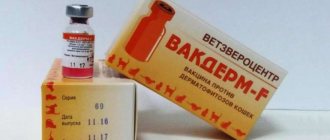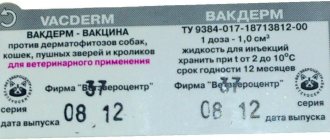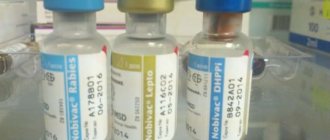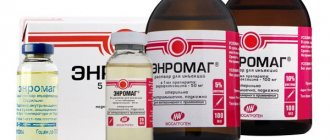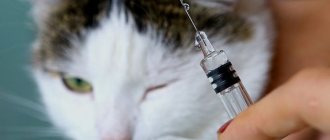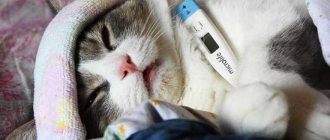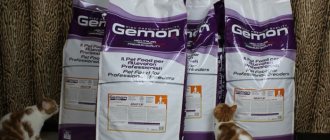Ringworm is a serious skin disease that affects both cats and dogs, as well as humans. It is caused by fungi of the genus Mycrosporum and Trichophyton, so in science the disease is called either microsporia or trichophytosis. From the point of view of the cat owner, there is no difference between them: the difference in symptoms is important for specialists, but the course of the disease in general and the treatment are very similar.
Find out more about how lichen is transmitted from a cat to a person>>>
Not only is lichen transmitted to humans, the treatment for this disease is quite long and requires significant efforts from owners to maintain hygiene in the home. And if one of the family members is sick, then until he recovers, you need to remain on sick leave.
Nobody wants such adventures, so the information that anti-lichen vaccines have been developed and are being used was greeted with enthusiasm all over the world. And then controversy began about the effectiveness of this rather expensive procedure.
So does it make sense to vaccinate cats against ringworm? Let's figure it out.
Composition and release form
The industry produces the vaccine in two versions. One is intended for several species of animals - this is Vakderm. The second one is aimed at cats - this is Vakderm F. Both varieties of Wakderm contain only one component - deactivated dermatophyte cells. Dermatophyte cultures are grown in a selective nutrient medium. The resulting cells are weakened and stabilized with a 0.3% formaldehyde solution.
Pets can become infected from homeless stray animals
The drug is supplied to the consumer in two forms: as a suspension, ready for injection, and as a powder. The injection material is a homogeneous beige or gray mixture without foreign impurities.
The medicine is available in glass containers. The liquid form of the medicine is also available in sealed ampoules. The powder containing the immunobiological preparation is packaged in glass containers.
Ampoules contain 1 dose of the drug with a volume of 1 cubic meter. cm. Containers contain from 1 to 450 doses. Minimum volume - 3 cubic meters. cm. 1-2 doses are placed in such containers. Three or more doses are placed in containers from 10 to 450 cubic cm. Vials are used as containers. For large volumes, graduated bottles are used.
Vakderm vaccine must be stored and transported in the cold.
Containers with medicine are marked. They contain the warning label “for animals” and the name of the vaccine. In addition, the following information is given: the name of the enterprise that manufactured the drug, volume in cubic meters. cm, serial number, concentration, date of manufacture, storage temperature, number of doses, expiration date and barcode.
The commercially produced vaccine is stored at a temperature of 2 to 10 °C. After 365 days from the date of release, the medicine must be disposed of. In addition to expired medications, medications stored in open or damaged ampoules and vials are prohibited for use.
The vaccine is disinfected before disposal. In 60 minutes at 124-128 °C and a pressure of 151.99 kPa, complete disinfection occurs. The disinfected vaccine is disposed of as usual, without special safety measures.
Individual bottles or ampoules with a capacity of up to 50 cubic meters. cm are placed in plastic or cardboard boxes. The package contains 10 containers. The bottles are separated by cardboard partitions.
Boxes with dry substance may contain bottles of liquid for dilution. The amount of liquid should correspond to the amount of dry vaccine. In each box containing Vakderm , instructions for use must be included. The packaging also contains detailed information about the medicine.
Packs (boxes) of medicines or medicine containers with a volume exceeding 50 cubic meters. cm are placed in boxes. The container can be made of wood, thick cardboard, or plastic. The weight of the box with medicine is no more than 15 kg. It contains a packing list containing an indication of the manufacturer, the name of the vaccine, the number of boxes in the box, and information about the packer.
Features of the drug
By studying the annotation for Vakderm you can find out the following important information:
- The shelf life of the vaccine is 1 year at t +2 to +10 degrees. The contents of an open bottle can only be used within 30 minutes. When for some reason the color or thickness of the drug has changed, then it is not recommended to use it anymore. According to the instructions, the bottle with the unsuitable mixture must be allowed to boil for 1 hour, and then it must be neutralized.
- The substance can be injected into babies who are 3 months old.
- Before using the vaccine, you need to arrange for your cat to be seen by a veterinarian. You need to be especially careful about the injection if the animal is very young or, on the contrary, elderly, also exhausted.
- It is not permissible to take the vaccine when the cat has a high fever, is ill with infectious or other diseases, is pregnant in the last months, or is feeding milk. When a cat has diseases other than dermatophytosis, it needs to be cured and, after the veterinarian’s approval, can be treated with Vakderm F.
- When the injection is given, your pet may experience: drowsiness, poor appetite, hardening of the skin at the injection site. Such symptoms occur in a cat only for 1-3 days.
- When dermatophytosis in a cat is in its infancy, receiving a vaccine may cause symptoms of the disease (hair loss, peeling skin, ulcers).
Biological properties
Vakderm belongs to the group of immunobiological drugs. Its therapeutic and preventive effect is its effect on the immune system. Thanks to the vaccine, the body's protective reserves are acquired, increased, and activated.
If you notice wounds and bald spots on your pet, you should immediately consult a veterinarian
Vakderm vaccine causes a targeted immunological reaction. The purpose of Vakderm is the destruction of fungal formations and the complete destruction of fungal cells in the animal’s body.
The effect of the vaccine becomes noticeable a month after a double injection. Immunity caused by the drug will be maintained for 365 days after vaccination. You don’t have to think about dermatophytosis for a whole year.
The vaccine is harmless and does not cause allergic reactions. An important advantage of Vakderm is that it not only prevents the disease, but also has a therapeutic effect. Symptoms of the disease are reduced and the coat is restored.
The animal recovers fairly quickly. There is a nuance. An animal whose appearance and behavior indicate complete recovery may remain a spreader of infection. Tests and cultures are required to confirm complete recovery.
Owner reviews about the drug Vakderm-F
I became acquainted with the Vakderm vaccine when my cat caught this infection. I was terribly scared, but the veterinarian reassured me - just three injections and the cat is healthy, not contagious and has immunity for a whole year! The doctor also said, it’s good that such a medicine was invented, otherwise previously it was necessary to treat the animals with smelly ointments or even euthanize them.
akylita, forum user
https://otzovik.com/review_122856.html
Normal prophylactic drug. The animal tolerates it well, at least we did not notice anything unusual in its behavior after vaccination.
Lex-Ta, forum user
https://irecommend.ru/content/khoroshaya-vaktsina-dlya-koshek-ot-lishaya
Doses and method of administration
The veterinary drug is administered intramuscularly twice, into the thigh. After the first injection, a pause of 12–14 days is taken. During this period of time, the animal is observed. Vaccination accelerates the manifestation of the symptomatic picture if the animal is infected and the disease is in the latent phase. If there are no allergic or other consequences, a second injection is given.
The vaccine is used not only as an immunological agent. To achieve a therapeutic result, Vakderm for cats is administered 2-3 times. Simultaneously with the injections, an external local antifungal agent is used, applying it to the affected area of the skin and coat. In severe cases, they switch to complex fungicidal medications.
Vakderm is injected intramuscularly into the animal’s thigh.
Preventive immunization provides the following doses:
- three-month and younger kittens are given a dose of 0.5 ml, older cats - 1 ml;
- Vakderm for dogs is used from 2 months of age - 0.5 ml, for more adults and weighing more than 5 kg - 1 ml;
- rabbits and other fur-bearing animals from 50 days of age receive a dose of 0.5 ml, older animals - 1 ml.
The vaccine is administered annually. According to one scenario: the first injection, then 10-14 days of observation, after that the second injection. An absolute requirement is deworming of animals. Measures to get rid of helminths are carried out 10 days before the Vakderm for lichen .
Possible complications
The vaccine manufacturer warns that after administration of Vakderm-F, the cat may become drowsy or have a fever. This state lasts a maximum of three days. Some owners note that a swelling forms at the injection site after vaccination. To speed up the resorption of the seal, it is recommended to lubricate the problem area once with an alcohol solution of iodine.
If a cat begins to noticeably show signs of lichen after vaccination, it means that the animal has already been infected and the incubation period has passed. In such a situation, after two weeks it is also necessary to re-inject the vaccine, maintaining the dosage according to the instructions for use. There are no more serious complications after Vakderm F.
Side effects
Vaccination carried out in accordance with the dosage usually does not cause side effects. Rarely, lumps may occur at the injection site. Over time, the seals dissolve. Animals may sleep more than usual. Drowsiness goes away in 2-3 days.
The drug is used to treat dogs, cats and rabbits
Contraindications
Vaccination is not given to the elderly, pregnant, malnourished, dehydrated or those with a fever. The veterinarian must be aware of whether the animal has undergone any treatment. When was deworming carried out? Are there any allergies to foods and medications? Based on these data and an assessment of the general condition, the issue of using Vakderm .
In addition, a cat, dog, or other pet may currently be treated for any diseases. They may be given medications. In this case, consultation with the treating veterinarian is necessary. To avoid an unpredictable reaction to the vaccine.
Reviews
Let's look at a few reviews about Vakderma for cats:
- One housewife does not recommend Vakderm F to those who are inclined to self-medicate four-legged animals, as she did. Last year she adopted two kittens from the yard, then took them to the vet the next day. The doctor suspected they had ringworm, collected tests and asked them to come back for conclusions later. But she wanted to force things, purchased a Vakderm F kit and gave injections on the same day, without reading the instructions, and didn’t even bother to remove the worms. As a result, one kitten died after 3 days, and the other was saved without the help of a veterinarian. She concluded that it is better to carry out such treatment in a clinic and after a doctor’s prescription. The kittens had dermatitis and not lichen at all.
- The woman has 10 years of experience working in a pet supply store. There is a positive opinion about the Vakderm F vaccine - a reliable manufacturer, low price, the product has proven itself to be effective and provides good protection for cats against shingles. Some owners are worried that after vaccination with the vaccine, the cat will begin to develop lichen and do not dare to get another injection. It’s in vain, because the symptoms will disappear after 1-3 days, and the cat’s immunity will be activated to fight lichen. She administers this drug to her pets – a dog and a cat – once a year as a precaution. I did not notice any adverse effects.
- A cat living in a woman’s house became infected with trichophytosis. The owner was very scared, because the child was half a year old at home, and the disease is known to be contagious. The doctor prescribed Vakderm F ointments and injections. She was afraid to give injections and therefore took her to the veterinary hospital several times. The doctor warned that the remedy was effective, but not easy on the liver and the side effect would be lethargy.
After two injections, the cat’s hair grew back on her receding hairline and her appearance became noticeably more beautiful. He believes that the vaccine, together with sulfur ointments, helped overcome the disease.
Storage conditions
Storage rules comply with the federal law on the circulation of medicines. Vakderm can be stored in cabinets, on racks, shelves, and in refrigerators. Unpacked vials and ampoules should not be exposed to light.
Storage conditions and periods are indicated in the instructions accompanying the medicine. Typically, the temperature should not be lower than 2 °C, higher than 10 °C. The vaccine cannot be stored for longer than a year. Drugs that have expired or were stored in inappropriate conditions are destroyed.
Pros and cons of the drug
The widespread use of Vakderm F is explained by several advantages. These include:
- prolonged action;
- ease of use;
- possibility of prevention and treatment.
global $ads_google; //data-ad-slot=”2475549904″ $ads_google = empty($ads_google) ? false : true; ?> if ($ads_google == false) {?>
$ads_google = true; ?> } ?>
When choosing Vacderm-F for cat vaccination, you should also remember about the existing disadvantages that either limit its use or impose certain requirements. The disadvantages include:
- Specific storage conditions for the product and a relatively short shelf life.
- Incompatibility of the drug for lichen with other medications of similar action.
- Presence of contraindications and side effects after vaccination.
Methods of personal protection when treating an animal
Dermatophytosis is an anthropozoonosis. That is, to diseases to which people and animals are susceptible. A person can become infected from an animal and another person. The infection destroys the hair and surface of the skin. Caused by microsporum and trichophyton fungi. When infected from a person, trichophytosis spores are transmitted; when infected from an animal, microsporia spores are transmitted.
The disease resulting from infection from a cat or dog lasts longer, is more difficult to cure and is more severe than that transmitted from person to person. Children and adults with weakened immune systems are at risk. Direct or indirect contact is the main route of infection.
When examining an infected cat or dog, caution must be exercised when vaccinating a healthy animal. The veterinarian carries out all manipulations in special clothing and medical gloves and a gauze mask, that is, he adheres to the usual safety measures.
